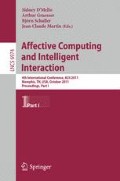Abstract
This article reviews the first of two experiments investigating the effect tailoring of training content has on a learner’s perceived engagement, and to examine the influence the Big Five Personality Test and the Self-Assessment Manikin (SAM) mood dimensions have on these outcome measures. A secondary objective is to then correlate signals from physiological sensors and other variables of interest, and to develop a model of learner engagement. Self-reported measures were derived from the engagement index of the Independent Television Commission-Sense of Presence Inventory (ITC-SOPI). Physiological measures were based on the commercial Emotiv Epoc Electroencephalograph (EEG) brain-computer interface. Analysis shows personality factors to be reliable predictors of general engagement within well-defined and ill-defined tasks, and could be used to tailor instructional strategies where engagement was predicted to be non-optimal. It was also evident that Emotiv provides reliable measures of engagement and excitement in near real-time.
Access this chapter
Tax calculation will be finalised at checkout
Purchases are for personal use only
Preview
Unable to display preview. Download preview PDF.
References
Woolf, B., Burleson, W., Arroyo, I., Dragon, T., Cooper, D., Picard, R.: Affect-Aware Tutors: Recognizing and Responding to Student Affect. International Journal of Learning Technology 4, 129–164 (2009)
Stevens, R.H., Galloway, T., Berka, C.: Integrating Innovative Neuro-Educational Technologies (I-Net) into K-12 Science Classrooms. In: Schmorrow, D., Reeves, L. (eds.) HCII 2007 and FAC 2007. LNCS (LNAI), vol. 4565, pp. 47–56. Springer, Heidelberg (2007)
Berka, C., Levendowski, D.J., Lumicao, M.N., Yau, A., Davis, G., Zivkovic, V.T., Olmstead, R.E., Tremoulet, P.D., Craven, P.L.: EEG Correlates of Task Engagement and Mental Workload in Vigilance, Learning, and Memory Tasks. Aviation Space and Environmental Medicine 78(5), B231–B244 (2007)
Rowe, J., Shores, L., Mott, B., Lester, J.: Integrating Learning and Engagement in Narrative-Centered Learning Environments. In: Proceedings of the 10th International Conference on Intelligent Tutoring Systems, Pittsburgh, pp. 166–177 (2010)
Peters, C., Asteriadis, S., Rebolledo-mendez, G.: Modelling user attention for human-agent interaction. In: 10th Workshop on Image Analysis for Multimedia Interactive Services, pp. 266–269 (2009)
Carini, R.M., Kuh, G.D., Klein, S.P.: Student Engagement and Student Learning: Testing the Linkages. Research in Higher Education 47(1), 1–32 (2006)
Wade, S., Buxton, W., Kelly, M.: Using Think-Alouds to Examine Reader-Text Interest. Reading Research Quarterly 34, 194–216 (1999)
Dragon, T., Arroyo, I., Woolf, B.P., Burleson, W., el Kaliouby, R., Eydgahi, H.: Viewing Student Affect and Learning through Classroom Observation and Physical Sensors. In: Woolf, B.P., Aïmeur, E., Nkambou, R., Lajoie, S. (eds.) ITS 2008. LNCS, vol. 5091, pp. 29–39. Springer, Heidelberg (2008)
McCrae, R.R., John, O.P.: An Introduction to the Five-Factor Model and Its Applications. Special Issue: The Five-Factor Model: Issues and Applications. Journal of Personality 60, 175–215 (1992)
Tang, A., Biocca, F., Lim, L.: Comparing Differences in Presence During Social Interaction in Augmented Reality Versus Virtual Reality Environments: An Exploratory Study. In: 7th International Workshop on Presence, Valencia, Spain (2004)
Lombard, M., Ditton, T.B., Weinstein, L.: Measuring (Tele)Presence: The Temple Presence Inventory. In: Twelfth International Workshop on Presence, Los Angeles, California, USA (2009)
Lessiter, J., Freeman, J., Keogh, E., Davidoff, J.: A Cross-Media Presence Questionnaire: the ITC-Sense of Presence Inventory. Presence 10(3), 282–297 (2001)
Inventado, P.S., Legaspi, R., Bui, T.D., Suarez, M.: Predicting Student’s Appraisal of Feedback in an ITS Using Previous Affective States and Continuous Affect Labels from EEG Data. In: Wong, S.L., et al. (eds.) Proceedings of the 18th International Conference on Computers in Education, Putrajaya, Malaysia (2010)
American Electroencephalographic Society Guidelines for Standard Electrode Position Nomenclature. Journal of Clinical Neurophysiology 8, 200–202 (2001)
Bradley, M.M., Lang, P.J.: Measuring emotion: The Self-Assessment Manikin and the Semantic Differential. Journal of Behavior Therapy and Experimental Psychiatry 25(1), 49–59 (1994)
Mehrabian, A.: Pleasure-Arousal-Dominance: A General Framework for Describing and Measuring Individual Differences in Temperament. Current Psychology 14, 261–292 (1996)
Fairclough, S.H., Venables, L.: Prediction of Subjective States from Psychophysiology: A Multivariate Approach. Biological Psychology 71, 100–110 (2006)
Chaouachi, M., Chalfoun, P., Jraidi, I., Frasson, C.: Affect and Mental Engagement: Towards Adaptability for Intelligent Systems. In: Proceedings of the 23rd International FLAIRS Conference. AAAI Press, Daytona Beach (2010)
Koutepova, T., Liu, Y., Lan, X., Jeong, J.: Enhancing Video Games in Real Time with Biofeedback Data. In: SIGGRAPH Asia, Seoul (2010)
Zhang, L.: Thinking Styles and the Big Five Personality Traits Revisited. Personality and Individual Differences 40, 1177–1187 (2006)
Author information
Authors and Affiliations
Editor information
Editors and Affiliations
Rights and permissions
Copyright information
© 2011 Springer-Verlag Berlin Heidelberg
About this paper
Cite this paper
Goldberg, B.S., Sottilare, R.A., Brawner, K.W., Holden, H.K. (2011). Predicting Learner Engagement during Well-Defined and Ill-Defined Computer-Based Intercultural Interactions. In: D’Mello, S., Graesser, A., Schuller, B., Martin, JC. (eds) Affective Computing and Intelligent Interaction. ACII 2011. Lecture Notes in Computer Science, vol 6974. Springer, Berlin, Heidelberg. https://doi.org/10.1007/978-3-642-24600-5_57
Download citation
DOI: https://doi.org/10.1007/978-3-642-24600-5_57
Publisher Name: Springer, Berlin, Heidelberg
Print ISBN: 978-3-642-24599-2
Online ISBN: 978-3-642-24600-5
eBook Packages: Computer ScienceComputer Science (R0)

